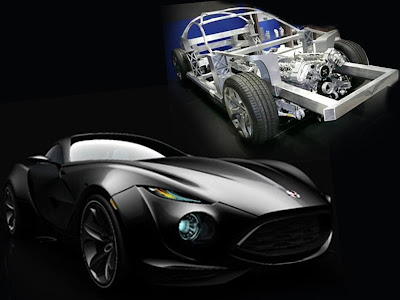 Cadillac Aera Concept Cars At 2010 LA Auto Show Design Challenge
Cadillac Aera Concept Cars At 2010 LA Auto Show Design Challengeadvanced
design California has come up with a
concept zero-emission vehicle as part of this year’s
LA Auto Show Design Challenge. Dubbed
Aera, the
concept vehicle weighs exactly 1000 pounds and needs refueling every 1000 miles. With an ability to seat four, the vehicle uses a body structure made from mono-formed 3D lattice that is extremely sturdy.

LOS ANGELES – The
Cadillac Aera concept cars vehicle won the
2010 Los Angeles Auto Show Design Challenge, tying with Smart and besting entries from seven other automakers including Mercedes-Benz, Honda, Nissan, Toyota and Maybach. GM Advanced Design has now won the honor more times than any other design team. This is the
Cadillac Aera, an amalgamation of Cadillac’s philosophy of “
Art and Science” that dives into a whole new world of innovative and
ultra lightweight vehicles. Aera is a 1000 lb, 2+2 touring coupe, with a range of 1000 miles before refueling; attributes achieved without compromising size, capacity and safety.
Cadillac Aera Concept Cars At 2010 LA Auto Show Design Challenge
This marks the third time that the group from General Motors has won this challenge, giving them the most wins out of all automakers that enter. The
Cadillac Aera Concept Cars At 2010 LA Auto Show Design Challenge hit on all areas that the judges were looking for and, despite the futuristic styling, still carries some recognizable lines from
Cadillacs of today.
Jussi Timonen, lead designer for the project shared: „The Cadillac Aera Concept Cars At 2010 LA Auto Show Design Challenge was designed to continue the forward-thinking imagination of Cadillac’s ‘art and science’ philosophy. It’s designed as a small city urban vehicle, but we approached this 2+2 touring coupe very much from the brand’s luxury perspective. Every detail of the Aera was conceived to minimize the vehicle’s environmental impact without sacrificing the style, comfort and attention to detail that are hallmarks of the
Cadillac brand.”
Cadillac Aera Concept Cars At 2010 LA Auto Show Design Challenge
The
Aera is powered by
compressed air via a highly efficient
Pneumatic Drive System that has a 10,000-psi composite air storage tank with capacity for a 1,000-mile range. Flexible, pressurized air cells in the exterior skin, similar to material developed for the NASA Mars Rover airbags, enhance passive safety and interior comfort. The flexible polymer skin optimizes aerodynamics and functions as an ultra-lightweight alternative to conventional body panels and glass.
Additional technologies include an All-In-One (AIO) wheel system, combining rotary actuator propulsion, steering and suspension functions. A drive by wireless system decreases the mass of electrical components. Vehicle to vehicle communication (V2V) promotes active safety. The Cadillac Aera embodies a stylistic, lightweight, minimalist approach to long distance luxury touring.
Cadillac Aera Concept Cars At 2010 LA Auto Show Design Challenge
The Design Challenge is part of the Design Los Angeles automobile designers’ conference and has evolved into an integral element of the Los Angeles Auto Show. Design Los Angeles connects those working in the design industry with well-known automotive design industry leaders. Los Angeles is home to the world’s largest concentration of manufacturer design studios, representing automakers from North America, Europe and Asia. It is also the home of Art Center College of Design, one of the world’s foremost transportation design institutions where many of today’s leading automotive designers began their careers.
 LOS ANGELES – The Cadillac Aera concept cars vehicle won the 2010 Los Angeles Auto Show Design Challenge, tying with Smart and besting entries from seven other automakers including Mercedes-Benz, Honda, Nissan, Toyota and Maybach. GM Advanced Design has now won the honor more times than any other design team. This is the Cadillac Aera, an amalgamation of Cadillac’s philosophy of “Art and Science” that dives into a whole new world of innovative and ultra lightweight vehicles. Aera is a 1000 lb, 2+2 touring coupe, with a range of 1000 miles before refueling; attributes achieved without compromising size, capacity and safety.
LOS ANGELES – The Cadillac Aera concept cars vehicle won the 2010 Los Angeles Auto Show Design Challenge, tying with Smart and besting entries from seven other automakers including Mercedes-Benz, Honda, Nissan, Toyota and Maybach. GM Advanced Design has now won the honor more times than any other design team. This is the Cadillac Aera, an amalgamation of Cadillac’s philosophy of “Art and Science” that dives into a whole new world of innovative and ultra lightweight vehicles. Aera is a 1000 lb, 2+2 touring coupe, with a range of 1000 miles before refueling; attributes achieved without compromising size, capacity and safety.































 This vehicle is a
This vehicle is a 











 Ghepardo is
Ghepardo is 


